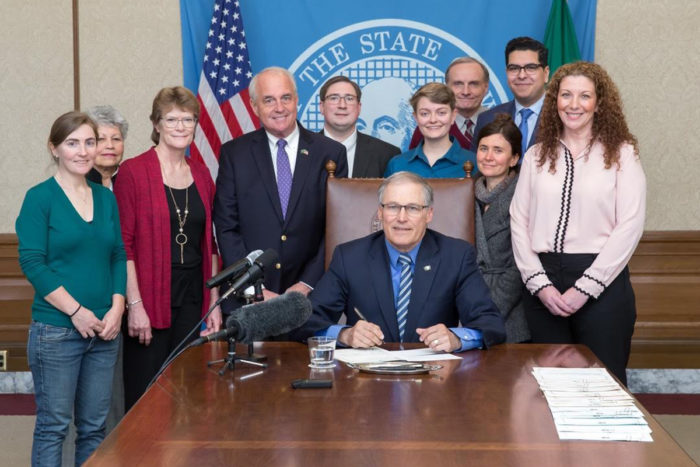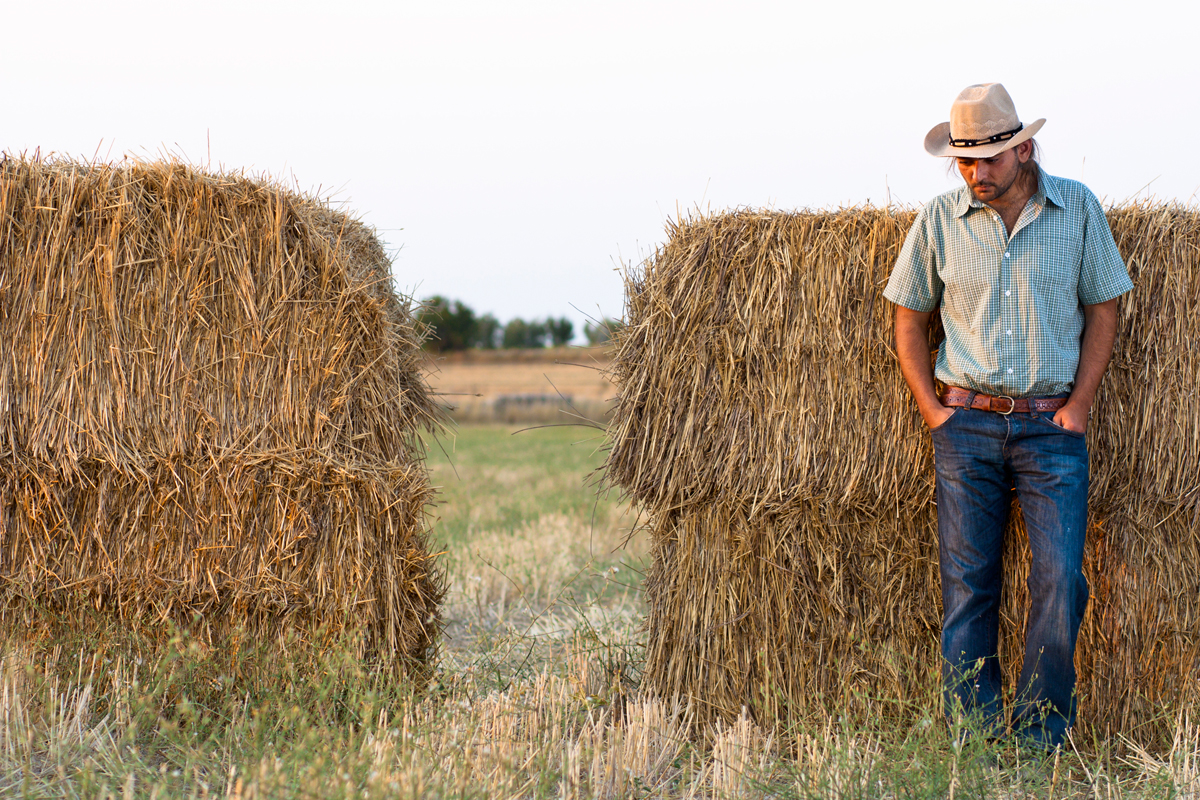Civil Eats: Suicide Rates Among Farmers are Alarmingly High. Can Federal Legislation Help?
by Lisa Held | 04.16.18
The STRESS Act would provide support, but some farmers say it’s little more than a band-aid and real policy changes are needed.
In a video posted to YouTube in 2014, Justin McClane gives the camera two thumbs up. He skips in a circle, holding the hands of fellow members of the Washington Young Farmers Coalition (WYFC). In a letter posted to Facebook in 2017, those peers, now heartbroken, informed their community of McClane’s death by suicide, expressing shock and sadness to have lost a colleague and friend at age 30.
Lucia Wyss, WYFC’s coordinator and a grain and pig farmer, said that before McClane died, it was common for farmers in the area to talk about hopelessness, isolation, and burnout among their peers. But, she added, “It just became horribly clear that the most extreme kind of burnout is suicide. It never occurred to us to talk about suicide and mental health explicitly.”
That’s changing now across the country. Over the past year, media reports in Newsweek, the New York Times, and an in-depth piece in The Guardian have called attention to alarming rates of suicide among farmers and farmworkers, from grain growers in the Midwest to dairy farmers in the Northeast.
As a result, lawmakers are responding with bills aimed at increasing access to behavioral health services like counseling and suicide hotlines. Washington state passed one bill last month, and advocates say other states are working on developing their own laws.
On the national front, Congressman Tom Emmer (R-MN) also introduced the Stemming the Tide of Rural Economic Stress and Suicide (STRESS) Act (H.R. 5259) last month, which would allocate federal funding to build and strengthen a national network of farmer support services. The bill already has significant bipartisan support in Congress and is being endorsed by a diverse group of 36 organizations involved in agriculture and rural life.
Experts and advocates say the legislation is desperately needed and could provide real help. But some affected farmers say it’s little more than a band-aid on a much deeper wound caused by years of policies that have favored consolidation and led to volatile markets, devastating price drops, and the hollowing-out of rural communities.
The Scope of the Problem
When reporting on the scope of the problem, most rely on data from a 2012 Centers for Disease Control (CDC) that breaks down U.S. suicide rates by occupation. People working in “farming, fishing, and forestry” had the highest rates compared to all other industries, at 84.5 per 100,000. That number is more than five times the national rate and is comparable to high suicide rates among military veterans.
While more recent data doesn’t exist, farmers and advocates point to anecdotal evidence that suggests suicide rates among farmers have been rising. Last spring, the National Farmers Union (NFU) launched an online resource called the Farm Crisis Center because “we really started hearing from a lot of our members that there are real, growing problems and there are a lot of farmers in crisis,” said Matt Perdue, NFU’s government relations representative.
Andrew Bahrenburg, national policy director at the National Young Farmers Coalition (NYFC), agreed. “Hotlines, farmer advocates—they’re all saying this getting worse, that there’s an increased demand for these services and we need more resources.”
While risk factors for farmers include isolation in rural areas, lack of control, and lack of access to behavioral health services, most farmers and advocates point to extreme financial stressors as the main cause of the problem. Corn and soy production is high, meaning prices are low. And overall net farm income has decreased 50 percent for U.S. farmers since 2013, and the U.S. Department of Agriculture (USDA) predicts it will drop further, to negative $1,316 in 2018.
A looming trade war is already affecting farmers in Middle America. The price of milk, which is set by the federal government, has dropped so low that dairy farmers are being paid significantly less for their milk than it costs to produce it.

Members of WYFC who worked for the passage of Washington state’s farmer suicide-prevention bill attending as the governor signed the bill into law.
Brenda Cochran and her husband have been milking cows since 1975 in Maryland and Pennsylvania and now operate a dairy farm in Northwestern Pennsylvania. On their last delivery, they were paid $14.39 per hundredweight, which means they lost about $7 per hundredweight, she said—fully one-third of their production costs.
Cochran, who runs Farm Women United with fellow farmer Tina Carlin, lists three deaths by suicide she’s heard about in her community since February: an Amish farmer, a farmer who was in a leadership position in a dairy association, and an agribusinessman who was carrying debilitating debt.
“We can’t solve this problem on our own because everyone is depressed, everyone is broken,” she said. “I understand why farmers are committing suicide. It’s been going on for so long. You are talking to a depressed farmer right now.”
What the STRESS Act Would Do
The proposed federal act wouldn’t improve the markets for farmers, or help them stay in business. But it would help provide behavioral health services that may help some people weather the hard times.
Many organizations and individuals have long been working to get such services in place. Michael Rosmann, a former organic farmer and rancher in Iowa and a clinical psychologist, has been at the forefront of a movement to recognize and prioritize “agricultural behavioral health” for decades.
In 2001, he became director of Agriwellness, a nonprofit formed as a network of counseling and hotlines in Iowa, Wisconsin, Minnesota, North Dakota, South Dakota, Nebraska, and Kansas. The program helped many farmers, but struggled with funding. Rosmann then got involved in an effort to use the model to develop a national plan called the Farm and Ranch Stress Assistance Network (FRSAN). FRSAN was included when the 2008 Farm Bill passed, but legislators never allocated the discretionary funding to launch it, so the program expired before it could take off.
The STRESS Act, proposed as a marker bill attached to the larger 2018 Farm Bill, would essentially just reauthorize the establishment of FRSAN. The bill’s broad organizational support and bipartisan co-sponsors—four other Republicans and five Democrats—suggest it has a good chance of inclusion in the final bill. Another promising sign is the fact that Washington state’s law aimed at preventing farmer suicide was passed unanimously in both the state house and senate and signed quickly by the governor.
However, the STRESS Act still would rely on discretionary funding for FRSAN. “We think we need to get it included [in the farm bill] any way we can and discretionary funding is best way to get bipartisan support,” NFU’s Perdue said. “Then we’ll have to keep the drumbeat up with the appropriations committees.”
Rosmann believes a fully funded FRSAN could really help farmers across the country, since many effective programs already exist but are struggling to stay afloat. And the network would rely on solutions that have already been shown to help.
“We know hotlines are used by farm people when they’re free, confidential, and available at all hours of the day and night and staffed by counselors who understand agriculture,” he explained. “Farm and ranch people often feel like they want somebody who understands their circumstances.”
Rosmann said he could see FRSAN having an impact comparable to the national AgrAbility program, which was established to help farmers with physical disabilities continue farming and reduce injuries. “Just like we help people with physical injuries, we need something that addresses the emotional toll,” he said.
Some farmers, however, resent that the focus is being shifted to counseling when what they really need is cash to pay their debts. Hotlines and counseling may help, but they won’t fix the deeper problems that are causing small farms and rural communities to collapse, leading to intense psychological distress. For example, when dairy cooperative Agri-Mark sent out a letter to its producers informing them that prices for milk would drop again for the third year in a row and included a list of suicide hotlines, many saw it as a slap in the face.
“Why do we need a STRESS Act? What is going on? Farmers don’t want to be taken through this. They need it to be fixed,” Cochran said. Instead, she proposed setting a limit so that the price of milk can’t drop below $20 per hundredweight. “The federal government is forcing traditional farms out of business, and there’s no safety net. Why would you even need a safety net if the government wasn’t throwing you off a cliff?”
